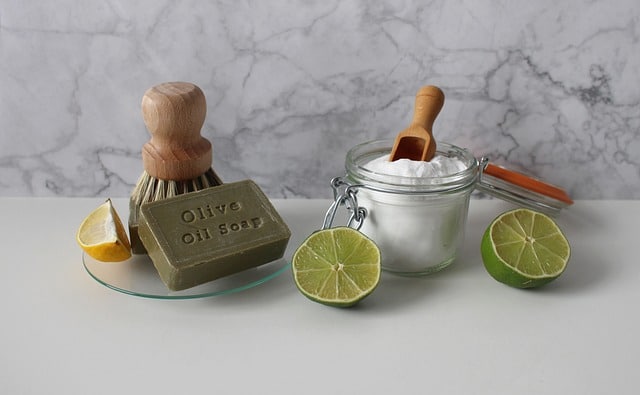Introduction – Transitioning To A Zero-Waste Bathroom
Transitioning to a zero-waste bathroom can be a daunting task, as there are many different areas to focus on. However, if you are looking for ways to help the environment next time you bring new products into your household, read on.
The bathroom is a source of household waste, from single-use plastic items like toothbrushes to shaving cartridges. However, it’s also one of the best rooms to transition towards zero-waste living. Start by replacing disposable products with reusable options. By making small changes and being conscious of our choices, we can create a zero-waste bathroom that helps reduce our environmental footprint.

Why Does The Bathroom Create So Much Waste?
Have you ever stopped to think about all the resources we use and dispose of in the bathroom daily? Between toilet paper, disposable feminine hygiene products, and single-use plastic items like toothbrushes and razors, it’s no wonder that the bathroom generates a significant amount of waste. And let’s not even get started on all the packaging for soaps, shampoos, and other personal care products.
A major contributor to this waste is our society’s emphasis on convenience. After all, who wants to deal with dirty cloth towels or reusable menstrual products when disposable options are widely available? However, there are simple steps we can take to reduce our bathroom waste – using reusable towels instead of disposable ones, opting for dental floss over plastic picks, and choosing environmentally friendly personal care products in minimal packaging are just a few examples. By being conscious of our bathroom habits and making small changes, we can make a real impact on reducing waste in this often overlooked area.
How to Transition Your Bathroom to Zero Waste
Identify Sustainable Alternatives
One of the most important things you can do when transitioning to a zero-waste bathroom is to purchase sustainable alternatives to everyday items. For example, consider purchasing unbleached bamboo toilet paper or cloth rags instead of using traditional toilet paper and paper towels in your bathroom. Both options are much more eco-friendly than their counterparts and will allow you to reduce your use of disposable materials significantly.
Use 3rd Party Certification
Additionally, by purchasing these types of products from sustainable businesses like those certified by the Forest Stewardship Council (FSC), you can rest assured that you are doing your part to help protect the environment.
Switch To Biodegradable Options
Another great way to reduce your impact in the bathroom is by using biodegradable cleaning products, such as organic soap and shampoo bars. These products are typically made from natural ingredients that break down easily once disposed of, rather than sitting in landfills for decades.
Consider Foundational Changes In Toilet Hardware
Of these options, the one that will be the most expensive is to consider installing composting toilets or waterless urinals in your home. Not only will this reduce your use of everyday consumables like toilet paper and water, but it can also help cut down on greenhouse gas emissions from the sewage treatment plants required with traditional plumbing systems.
Go From Small To Large Changes
Overall, transitioning to a zero-waste bathroom can be a rewarding experience and will help reduce your impact on the environment. By considering the materials you use and making small changes, you can feel good about your contribution to reducing waste in your community and beyond.
What Goes Into a Zero Waste Bathroom?
A zero-waste bathroom is a space that prioritizes sustainability and relies on reusable or biodegradable products wherever possible. Some key elements of a zero-waste bathroom might include the following:
Unbleached bamboo toilet paper rolls, which are often made from sustainably sourced materials
Cloth rags for cleaning up spills and messes instead of disposable paper towels
Environmentally friendly personal care products, such as organic shampoo bars, unpackaged soaps, and natural deodorants
Bamboo toothbrushes instead of the common plastic versions; more generally, any eco-friendly toothbrush alternatives to plastic including electric heads.
Composting toilets or waterless urinals to reduce your use of water and other resources in the bathroom
Overall, creating a zero-waste bathroom requires a commitment to sustainability, but the result is a space that minimizes waste and helps protect the environment.
Benefits of Having a Zero Waste Bathroom
The bathroom is one of the most frequently overlooked places for implementing zero-waste habits. You can significantly reduce your environmental impact and save money by making simple changes in your bathroom routine.
First, switch to reusable cloth towels instead of paper towels for wiping up spills or drying hands.
Secondly, switch to natural fiber washcloths instead of disposable cotton rounds for removing makeup or applying toner. You can also eliminate disposable plastic by using bar soap instead of liquid body wash and switching to a bamboo toothbrush with biodegradable bristles.
Adopting zero waste habits in your bathroom helps reduce wasteful spending and the amount of non-biodegradable waste ending up in landfills. So next time you’re in the bathroom, consider how small changes can make a big difference in creating a more sustainable routine.
How to Reduce Plastic in Your Bathroom?
In our current throwaway economy, plastic is everywhere – and the bathroom is no exception. From disposable razors to plastic-packaged shampoo, it’s easy to contribute to the mounting levels of plastic waste. However, there are several steps you can take to decrease your plastic usage in the bathroom.
To start, switch to reusable razor blades or a safety razor. Not only will this reduce the amount of single-use plastic, but it will also save you money in the long run. Next, look for packaging-free or biodegradable options when purchasing personal care products such as shampoo and soap. Many zero-waste or natural stores offer these alternatives and can be easily ordered online.
Finally, consider ditching disposable cotton rounds or makeup wipes in favor of washable cloths or a soft washcloth. By taking these steps, you can do your part to decrease plastic waste and live a more sustainable lifestyle.

How to Choose Environmentally Friendly Personal Care Products?
When shopping for personal care products, it can be difficult to determine which ones are environmentally friendly. One important factor is whether the product is packaged in plastic or biodegradable materials. Seeking out products with minimal packaging and purchasing refillables will also help reduce waste.
Another way to ensure a product is eco-friendly is by checking its ingredients. Steer clear of synthetic fragrances, parabens, phthalates, and sulfates, as these chemicals can pollute water sources and harm wildlife. Finally, look for cruelty-free personal care items, meaning they were not tested on animals.
Wrapping Up
In conclusion, there are many ways to make your bathroom more sustainable and environmentally friendly. From switching to reusable materials like cloth towels and washcloths to opting for products with natural ingredients, taking these steps can help reduce waste and minimize your impact on the planet. Whether you’re ready to fully commit to a zero-waste lifestyle or simply want to make small changes, committing to sustainable personal care habits is an important step in creating a greener home.
